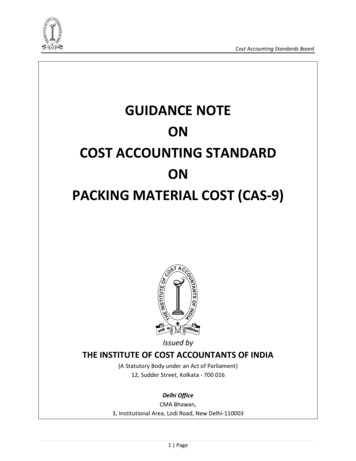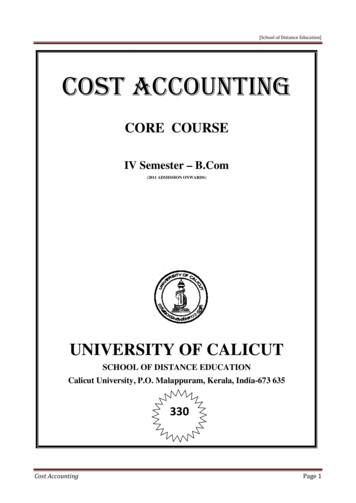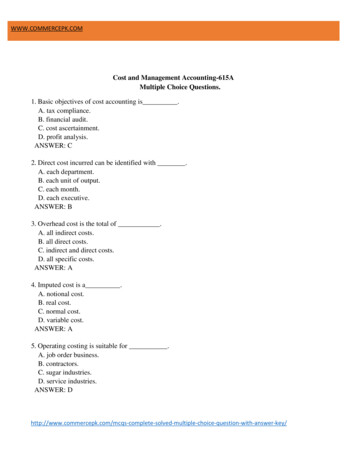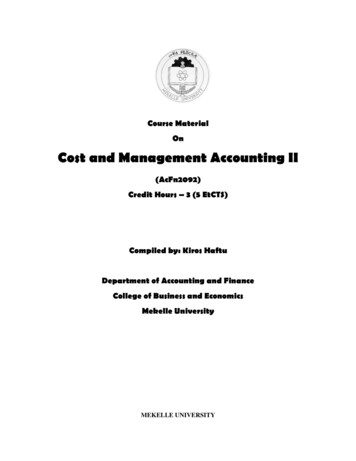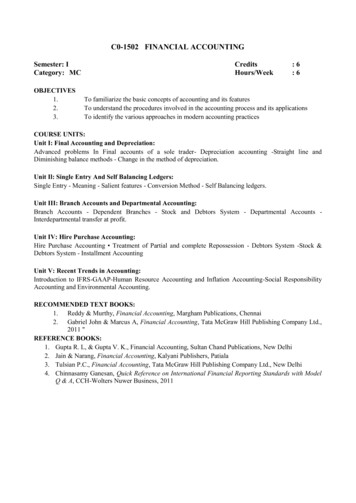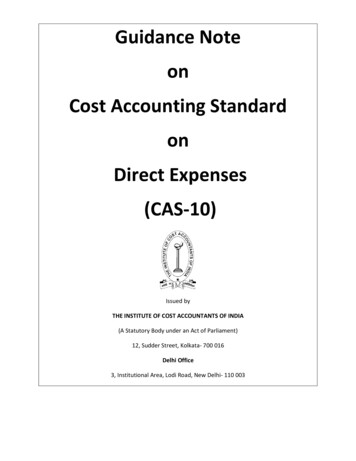
Transcription
Guidance NoteonCost Accounting StandardonDirect Expenses(CAS-10)Issued byTHE INSTITUTE OF COST ACCOUNTANTS OF INDIA(A Statutory Body under an Act of Parliament)12, Sudder Street, Kolkata- 700 016Delhi Office3, Institutional Area, Lodi Road, New Delhi- 110 003
Cost Accounting Standards BoardList of s63Principles of Measurement74Assignment of Cost Accounting Standard- 10 on DirectExpensesPage 2 of 24Page18
Cost Accounting Standards BoardGuidance Note onCost Accounting Standard on Direct Expenses (CAS-10)The Council of the Institute of Cost Accountants of India has issued the Cost AccountingStandard -10 (CAS-10) on Direct Expenses which lays down a set of principles and methods ofclassification , measurement and assignment of Direct Expenses for determination of the costof product or service and the presentation and disclosure in the cost statements. The CostAccounting Standards have been set in bold italic type and reference number of the standardhas been retained.The Guidance Note deals with principles and methods as provided in the CAS-10 and practicalaspects in connection with the determination of Direct Expenses for a product or service. In thepreparation of cost statement and its attestation, Direct Expenses should be determined withreference to CAS-10.The Companies (Cost Accounting Records) Rules, 2011 provide that every company, including aforeign company defined under section 591 of the Companies Act, 1956 which is engaged inproduction, processing, manufacturing or mining activities have to maintain cost accountingrecords in accordance with the Generally Accepted Cost Accounting Principles (GACAP) andCost Accounting Standards issued by the Institute, to the extent these are found to be relevantand applicable. The above Rules further provide that these will be applicable to companieswherein:(a) aggregate value of net worth as on the last date of the immediately preceding financialyear exceeds five crores of rupees; or(b) the aggregate value of the turnover made by the company from sale or supply of allproducts or activities during the immediately preceding financial year exceeds twentycrores of rupees; or(c) the company’s equity or debt securities are listed or are in the process of listing on anystock exchange whether in India or outside India.The Companies (Cost Audit Report) Rules 2011 cast a duty on a Cost Auditor appointed underSection 233B of the Companies Act, 1956 to certify inter alia that books and recordsmaintained by the company are in conformity with the Cost Accounting Standards issued by theInstitute to the extent these are found to be relevant and applicable.Page 3 of 24
Cost Accounting Standards BoardChapter 1IntroductionDirect Expenses are the expenses relating to manufacture of a product or rendering of aservice which can be identified or linked with the cost object other than those incurred ondirect material and direct employee cost.Examples of Direct Expenses are royalties charged on the basis of production, job charges, hirecharges for use of specific equipment for a specific product, cost of special designs or drawingsfor a product, software services specifically required for a job product, travelling expenses for aspecific product. These are dealt below:(i)Royalty: Royalty is to be paid to Collaborators or technology suppliers in terms ofagreement entered with them. It is payable either in relation to production or sales during theaccounting period. If royalty payment is to be computed on the basis of production the sameshould be treated as Direct Expenses. Royalty for Upgrading Technology for the product willbe included in cost of production, irrespective of whether it is paid on production basis or salesbasis. Royalty for Marketing and Distribution, if paid, will be excluded from cost of production.(ii)Technical Assistance/Know-how fees:Technical Assistance/know-how fees are paid for acquiring Technical assistance /Know-how.Custom duty paid/payable at the time of import of technical knowhow is treated as part of costof technical knowhow. This is to be reflected as a line item under paragraph 5 – Abridged CostStatement of the Companies (Cost Audit Report) Rules, 2011.(iii) Job/Processing charges for a product: Job Work Charges/Processing Charges which aredirectly identified or linked with the products will form part of Direct Expenses. Job charges maybe for a specific product or for job on contract basis for a product.(iv) Hire charges for tools etc: Hire charges in respect of tools and equipments which can bedirectly identified with a particular product will form part of Direct Expenses. Hire charges forPage 4 of 24
Cost Accounting Standards Boardtools for general use is in the nature of indirect Expenses and is to be included in productionoverheads.(v) Charges for a particular product designing etc: Product design charges in respect of toolswhich can be directly identified with a particular product will form part of Direct Expenses. Forexample, special design was to be developed for a tool as per customer requirements and suchexpenses incurred in designing of a tool for the product would be treated as Direct Expenses forthe product.Page 5 of 24
Cost Accounting Standards BoardCHAPTER 24.DefinitionDefinitions4.1 Abnormal cost: An unusual or atypical cost whose occurrence is usually irregular andunexpected and/ or due to some abnormal situation of the production or operation.14.2 Cost Object: This includes a product, service, cost centre, activity, sub-activity, project,contract, customer or distribution channel or any other unit in relation to which costs areascertained.24.3 Direct Employee Cost: The cost of employees which can be attributed to a cost object in aneconomically feasible way.34.4 Direct Expenses: Expenses relating to manufacture of a product or rendering a service,which can be identified or linked with the cost object other than direct material cost anddirect employee cost4.4.5 Direct Material Cost: The cost of material which can be attributedeconomically feasible way5.to a cost object in an4.6 Finance Costs: Costs incurred by an enterprise in connection with the borrowing of funds.4.7 Imputed Costs: Hypothetical or notional costs, not involving cash outlay, computed forany purpose.64.8 Overheads: Overheads comprise of indirect materials, indirect employee costs and in DirectExpenses which are not directly identifiable or allocable to a cost object.74.9 Standard Cost: A predetermined cost of resource inputs for the cost object computed withreference to1setof technicalAdapted from CAS 1 paragraph 6.5.19Adapted from CIMA Terminology3Adapted from CAS 1 paragraph 6.2.4 (Direct labour cost)4Adapted from CAS 1 paragraph 6.2.65Adapted from CAS 1-6.2.36Adapted from CAS 1 paragraph 6.5.137Adapted from CAS 3 paragraph 4.12Page 6 of 24specificationsandefficientoperating conditions.
Cost Accounting Standards BoardCHAPTER 3Principles of Measurement5. Principles of Measurement:5.1 Identification of Direct Expenses shall be based on traceability in an economicallyfeasible manner.Measurement of Direct Expenses depends upon identification and traceability to cost object/product in an economically feasible manner. The cost object includes a product, service, costcentre, activity, sub-activity, project, contract, customer or distribution channel or any otherunit in relation to which costs are ascertained.8 It is the logical sub-unit for accumulation ofcost.If an expense can be identified with a cost object /product and is sufficient material inamount, it is treated as Direct Expenses. It must also be economically feasible to associateDirect Expenses with units produced. “Economically feasible manner” means cost effectivenessfor identification of direct expense and such identification should not be too expensive inrelation to expected benefits.5.2.1 Direct Expenses incurred for the use of bought out resources shall be determined atinvoice or agreed price including duties and taxes, and other expenditure directlyattributable thereto net of trade discounts, rebates, taxes and duties refundable or to becredited.Direct Expenses are incurred for the use of bought out resources.These are:Royalties charged on production, job charges, hire charges for use of specific equipment for aspecific product, cost of special designs or drawings/ software services specifically required fora product and the like.In such case determination of Direct Expenses incurred for a cost object will depend upon thetype of Direct Expenses. For Example, royalty payment is to be determined in terms of8Adapted from CIMA TerminologyPage 7 of 24
Cost Accounting Standards Boardcollaboration agreement. Job /hire charges will be as per work order and invoice. It shallinclude duties and taxes and other expenditure (freight/transport). Direct Expenses are to benet of any discount, rebate, taxes and duties (VAT/CENVAT) refundable, if any.If any design and drawing is imported, custom duty payable/paid, insurance andfreight/courier charges if any, will form part of the cost. Supplier will be paid full amount asper invoice. In case Excise Duty/Cess and VAT are refundable, cost of these will be net of theserefunds.5.2.2 Direct Expenses other than those referred to in paragraph 5.2.1 shall be determined onthe basis of amount incurred in connection therewith.Dies, tools, scaffolding, and so on are sometime produced internally. Production Cost of theseitems is to be determined taking into account the direct material cost, direct employee cost,Direct Expenses and production overhead. As and when a decision is taken to producedies/tools in house, all the above expenses are recorded. Direct material cost is to bemeasured as per paragraph 5.1 of CAS on Material Cost (CAS-6). The receipt of material shallbe valued at purchase price including duties and taxes, freight inwards and other expenditureattributable to procurement. The material cost is to be adjusted for trade discounts, rebates,taxes and duties refundable or to be credited by the taxing authorities.Similarly benefit of import entitlement is to be credited.Direct employee cost for internally produced dies, tools etc is to be measured as perparagraph 5.1 of CAS on Employee Cost (CAS-7). It shall take into account the gross payincluding all allowances payable along with the cost to the employer of all the benefits. Theshare of production overhead is to be determined as per CAS-3. Expenses incurred fordevelopment and improvement of the process for existing product shall be identified as DirectExpenses.5.2.3 Direct Expenses paid or incurred in lump-sum or which are in the nature of ‘one – time’payment, shall be amortised on the basis of the estimated output or benefit to be derivedfrom such Direct Expenses.Page 8 of 24
Cost Accounting Standards BoardIn case of lump sum payment or one-time payment, for which benefit is expected in futureperiod, it shall be written off over its useful life. For example Technical know-how fee paidshall be amortized over its useful life.5.3 If an item of Direct Expenses does not meet the test of materiality, it can be treated aspart of overheads.Whether an item of expense is to be treated as Direct expense or indirect expense, is to bedetermined in terms of materiality of an item. Materiality has not been defined in the standard.Materiality depends on the size and nature of item judged in particular circumstances. An itemof expense is considered material if its omission could influence the economic decisions ofusers of the cost statement. For example Royalty is a material item of cost. It is to be indicatedin the cost statement as a separate item under the Companies (Cost Audit Report) Rules, 2011and not aggregated with production overhead even though it may not be significant in term ofthe total cost of the product. In another case, job charges can be identified with the cost objectbut not being material and significant in value, it may be treated as Production overhead.5.4 Finance costs incurred in connection with the self generated or procured resourcesshall not form part of Direct Expenses.Finance costs are interest and similar charges payable for borrowed funds. Finance costsare excluded from Direct Expenses.5.5 Direct Expenses shall not include imputed costs. In case of goods produced forcaptive consumption, treatment of imputed cost shall be in accordance with CostAccounting Standard – 4 (CAS-4).Imputed cost does not involve at any time any outright expense or cash outlay. As such itis to be excluded from Direct Expenses. However in case of goods produced for captiveconsumption, imputed cost is to be considered while determining the cost of goodsproduced as per Cost Accounting Standard – 4 (CAS-4).Paragraph 5.14 of CAS-4 provides that In case any input material, whether of direct or indirectnature, including packing material is supplied free of cost by the user of the captive product,the landed cost of such material shall be included in the cost of production. Landed cost ofPage 9 of 24
Cost Accounting Standards Boardinputs received free of cost should be calculated as per the guidelines relating to material cost.Paragraph 5.15 of CAS-4 further provides that imputed cost is to be charged for Moulds, Tools,Dies & Patterns etc received free of cost. The amortization cost of such items shall be includedin the cost of production. Amortisation should be done on the basis of estimated productionthat can be achieved during the life of the Mould, Tool, Die or Pattern.5.6 Where Direct Expenses are accounted at standard cost, variances due to normalreasons shall be treated as part of the Direct Expenses. Variances due to abnormalreasons shall not form part of the Direct Expenses.If standards have been fixed for any Direct Expenses, such as job charges, and the like,variance of Direct Expenses shall be analyse. Variance due to normal reason shall formpart of Direct Expenses and any abnormal variance shall be excluded from DirectExpenses. The variance analyses enables management to observe the extent to whichactual Direct Expenses are differing from predetermined estimates.5.7 Any Subsidy/Grant/Incentive or any such payment received/receivable with respectto any Direct Expenses shall be reduced for ascertainment of the cost of the cost objectto which such amounts are related.Subsidy and grant received/receivable for Direct Expenses should be deductedtherefrom.5.8 Any abnormal portion of the Direct Expenses where it is material and quantifiableshall not form part of the Direct Expenses.Abnormal cost has been defined under paragraph 4.1 of CAS-10. The rationale ofexclusion is that inclusion of such items in the cost will make the cost not comparablewith a normal situation. Such an aberration is avoided to understand the cost in a betterperspective for any purpose.Page 10 of 24
Cost Accounting Standards BoardIllustration:Certain Direct Expenses were incurred on design and drawing , but due to change in thespecification of the product, these drawings were abandoned and were treated asabnormal cost as being material and quantifiable and will not form part of the DirectExpenses.5.9 Penalties, damages paid to statutory authorities or other third parties shall not form partof the Direct Expenses.Penalties/damages are levied by the statutory authorities for non-compliance with statutoryrequirements/delay. Penalties/Damages are an abnormal cost and do not form part of theDirect Expenses. It is charged to Profit & Loss account.5.10 Credits/ recoveries relating to the Direct Expenses, material and quantifiable, shall bededucted to arrive at the net Direct Expenses.If any credit is available relating to Direct Expenses, it is to be deducted from the DirectExpenses for a product.5.11 Any change in the cost accounting principles applied for the measurement of the DirectExpenses should be made only if, it is required by law or for compliance with the requirementsof a cost accounting standard, or a change would result in a more appropriate preparation orpresentation of cost statements of an organisation.Principles applied for determining the Direct Expenses be followed consistently. For exampleprofit sharing bonus paid to employees was not to be treated as a part of production cost but of“Total cost of Sales” under previous Cost Audit Report Rules 1996.This principle was beingfollowed consistently but due to change in the principle with the notification of the Companies(Cost Accounting Records) Rules,2011 bonus is now part of the employee cost and forms partof cost production. Thus change in cost accounting principle/law for determining the cost canbe made when required by any law as illustrated above or for compliance with cost accountingstandards or it results in more appropriate presentation of cost statement.Page 11 of 24
Cost Accounting Standards BoardCHAPTER 4Assignment of Costs6. Assignment of costs6.1 Direct Expenses that are directly traceable to the cost object shall be assigned to that costobject.Assignment of Direct Expenses involves establishing a suitable procedure to identify andrecord the same by cost object.Invoice/Agreement/Job on contract are the sourcedocuments indicating details of Direct Expenses. For internally produced tools, Work Order isthe source for assignment of cost. These documents record the cost object /costcentre/product, and items listed are charged at their acquisition cost.Page 12 of 24
Cost Accounting Standards BoardCHAPTER 5Presentation7. Presentation7.1 Direct Expenses, if material, shall be presented as a separate cost head with suitableclassification. For example Subcontract charges Royalty on productionDirect Expenses are to be reflected in the cost statement as a separate item of expense if theseare material. Materiality has not been defined in the standard. What is considered material orimmaterial depends upon the situation.The following criteria can be applied for determining the materiality. No one criterion isdeterminative in and of itself. The absolute amount – the larger the amount , the more likely that it is material. The amount of cost of a product compared to the amount of Direct Expenses underconsideration – the greater the proportion of the considered amount of DirectExpenses versus the cost of product, the more likely it is material. The relationship of Direct Expenses with product. The cumulative impact of individual immaterial items - do they offset one anotheror do they accumulate in one direction (increase or decrease). The cost of determining the Direct Expenses.Page 13 of 24
Cost Accounting Standards BoardCHAPTER 6Disclosures8. Disclosures8.1The cost statements shall disclose the following:8.1.1 The basis of distribution of Direct Expenses to the cost objects/ cost units.Disclosure is to be made relating to the basis adopted for distribution of direct cost toproduct/ unit in the cost statement or by way of foot note.8.1.2 Quantity and rates of items of Direct Expenses, as applicable.Disclosure is to be made in the cost statement both in quantity and rates of items ofDirect Expenses. Certain Direct Expenses are paid in lump sum. Details wherequantitative information cannot be disclosed, shall be mentioned in the cost statement.Example:Royalty of Rs 10.25 lakhs has been determined @ 3% of cost of Production.8.1.3 Where Direct Expenses are accounted at standard cost, the price and usagevariancesIf the Direct Expenses are accounted at standard cost , the price and usage variances areto be disclosed in the cost statement.8.1.4 Direct Expenses representing procurement of resources and expenses incurred inconnection with resources generated.Disclosure is to be made for Direct Expenses both for procurement of resources andresources generated internally:Example:Page 14 of 24
Cost Accounting Standards BoardDirect Expenses :1. Special Design and Drawing procuredRs 250,0002. Tools & Dies produced internally:MaterialRs 36000LabourRs 12000OverheadRs 6000TotalRs 54,0008.1.5 Direct Expenses paid/ payable to related parties9.The related parties have been defined under the Companies (Accounting Standards) Rules,2006. If Direct Expenses is paid /payable for any supply procured from or supplied to relatedparties, its relationship, nature of transaction viz quantity, rate, other terms/ conditions ofprocurement are to be disclosed. The objective of disclosure is to ascertain that the transactionis at arm’s length and on purely commercial terms.8.1.6 Direct Expenses incurred in foreign exchange.Payment made in foreign exchange for the Direct Expenses relating to import ofdesign/drawing, royalty etc shall be indicated in the cost statement as a footnote.Example: Royalty paid in foreign exchange as per Collaboration Agreement:Royalty was paid US 5600 on production during the current year (Previous year US 4500).8.1.7 Any Subsidy/Grant/Incentive and any such payment reduced from Direct Expenses.Any subsidy/grant/incentive received relating to Direct Expenses is to be deducted from theDirect Expenses of the product and disclosure made accordingly by way of a foot note8.1.8 Credits/recoveries relating to the Direct Expenses.If any credit or recovery is considered while determining the Direct Expenses, the same shallbe disclosed in the body of the cost statement.9Related party as per the applicable legal requirements relating to the cost statement as on the date of the statementPage 15 of 24
Cost Accounting Standards Board8.1.9 Any abnormal portion of the Direct ExpensesAbnormal portion of Direct Expenses of a product is to be excluded from the cost of theproduct as the same has not contributed to the product. Disclosure is to be made by way offoot note in the cost statement.For example : During the year there was a fire resulting in loss of special design anddrawings developed for improved process valued at Rs 2.50 lakhs. The same has beenexcluded from the development cost.8.1.10 Penalties and damages paid etc. excluded from the Direct Expenses.Penalties and damages paid are not an item of cost as these are levied for non compliance withregulatory /contractual requirements. These are to be quantified and excluded from cost anddisclosure made as a footnote in the cost statement.8.2Disclosures shall be made only where material, significant and quantifiable.Level of materiality and significance has not been stated in the standard. What is consideredmaterial or immaterial depends upon the situation. A piece of information is material, if its nondisclosure could influence the decision of user.8.3Disclosures shall be made in the body of the Cost Statement or as a foot note or as aseparate schedule.Disclosure in the body of cost statement will depend on nature and materiality of DirectExpenses. If it forms material part of the Direct Expenses and can be identified with a productthe same shall be disclosed in the cost statement otherwise, disclosures may be by way of footnote.8.4 Any change in the cost accounting principles and methods applied for the measurementand assignment of the Direct Expenses during the period covered by the cost statement whichhas a material effect on the Direct Expenses. Where the effect of such change is notascertainable wholly or partly the fact shall be indicated.Page 16 of 24
Cost Accounting Standards BoardCost Accounting principles, and methods applied for the measurement and assignment ofDirect Expenses are to be applied consistently between one period and another uniformlyapplied for different Direct Expenses. If any change is made in these principles and methodswhich results in material impact on the cost of product, the same shall be disclosed in the coststatement or by a foot note. In case the impact of change in principles and methods of costaccounting is not ascertainable, the fact is to be disclosed by a note to the cost statements.Page 17 of 24
Cost Accounting Standards BoardANNEXURE I(CAS-10)COST ACCOUNTING STANDARD ON DIRECT EXPENSESThe following is the COST ACCOUNTING STANDARD – 10 (CAS-10) issued by the Council of TheInstitute of Cost and Works Accountants of India on “DIRECT EXPENSES”, for comments. Inthis Standard, the standard portions have been set in bold italic type. This standard should beread in the context of the background material which has been set in normal type.1. Introduction1.1 This standard deals with the principles and methods of determining the Direct Expenses.1.2 This standard deals with the principles and methods of classification, measurementand assignment of Direct Expenses, for determination of the cost of product or service,and the presentation and disclosure in cost statements.2. ObjectiveThe objective of this standard is to bring uniformity and consistency in the principles andmethods of determining the Direct Expenses with reasonable accuracy.3. ScopeThis standard should be applied to cost statements, which require classification,measurement, assignment, presentation and disclosure of Direct Expenses including thoserequiring attestation.Page 18 of 24
Cost Accounting Standards Board4. DefinitionsThe following terms are being used in this standard with the meaning specified.4.1 Abnormal cost: An unusual or atypical cost whose occurrence is usually irregular andunexpected and/ or due to some abnormal situation of the production or operation.104.2 Cost Object: This includes a product, service, cost centre, activity, sub-activity, project,contract, customer or distribution channel or any other unit in relation to which costs areascertained.114.3 Direct Employee Cost: The cost of employees which can be attributed to a cost objectin an economically feasible way.124.4 Direct Expenses: Expenses relating to manufacture of a product or rendering a service,which can be identified or linked with the cost object other than direct material cost anddirect employee cost13. Examples of Direct Expenses are royalties charged on production,job charges, hire charges for use of specific equipment for a specific job, cost of specialdesigns or drawings for a job, software services specifically required for a job, travellingExpenses for a specific job.4.5 Direct Material Cost: The cost of material which can be attributed to a cost object inan economically feasible way14.4.6 Finance Costs: Costs incurred by an enterprise in connection with the borrowing offunds. This will include interest and commitment charges on bank borrowings, other shortterm and long term borrowings, amortisation of discounts or premium related toborrowings, amortisation of ancillary cost incurred in connection with the arrangements ofborrowings, finance charges in respect of finance leases, other similar arrangements andexchange differences arising from foreign currency borrowings to the extent they are10Adapted from CAS 1 paragraph 6.5.19Adapted from CIMA Terminology12Adapted from CAS 1 paragraph 6.2.4 (Direct labour cost)13Adapted from CAS 1 paragraph 6.2.614Adapted from CAS 1-6.2.311Page 19 of 24
Cost Accounting Standards Boardregarded as an adjustment to the interest costs15. The terms Finance costs and Borrowingcosts are used interchangeably.4.7 Imputed Costs: Hypothetical or notional costs, not involving cash outlay, computed forany purpose.164.8 Overheads: Overheads comprise of indirect materials, indirect employee costs andindirect expenses which are not directly identifiable or allocable to a cost object.174.9 Standard Cost: A predetermined cost of resource inputs for the cost object computedwith reference to set of technical specifications and efficient operating conditions.Standard costs are used as scale of reference to compare the actual costs with the standardcost with a view to determine the variances, if any, and analyse the causes of variances andtake proper measure to control them. Standard costs are also used for estimation.15Adapted from CIMA TerminologyAdapted from CAS 1 paragraph 6.5.1317Adapted from CAS 3 paragraph 4.116Page 20 of 24
Cost Accounting Standards Board5. Principles of Measurement:5.1 Identification of Direct Expenses shall be based on traceability in an economicallyfeasible manner.5.2.1 Direct expenses incurred for the use of bought out resources shall be determined atinvoice or agreed price including duties and taxes, and other expenditure directlyattributable thereto net of trade discounts, rebates, taxes and duties refundable or to becredited.5.2.2 Direct expenses other than those referred to in paragraph 5.2.1 shall be determinedon the basis of amount incurred in connection therewith.Examples: in case of dies and tools produced internally, the cost of such dies and tools willinclude direct material cost, direct employee cost, direct expenses, factory overheadsincluding share of administrative overheads relating to production comprising factorymanagement and administration.In the case of research and development cost, the amount traceable to the cost object fordevelopment and improvement of the process for the existing product shall be included inDirect Expenses.5.2.3 Direct Expenses paid or incurred in lump-sum or which are in the nature of ‘one –time’ payment, shall be amortised on the basis of the estimated output or benefit to bederived from such direct expenses.Examples: Royalty or Technical know-how fees, or drawing designing fees, are paid forwhich the benefit is ensued in the future period. In such case, the production / servicevolumes shall be estimated for the effective period and based on volume achieved duringthe Cost Accounting period, the charge for amortisation be determined.Page 21 of 24
Cost Accounting Standards Board5.3 If an item of Direct Expenses does not meet the test of materiality, it can be treated aspart of overheads.5.4 Finance costs incurred in connection with the self generated or procured resourcesshall not form part of Direct Expenses.5.5 Direct Expenses shall not i
Cost Accounting Standards Board Page 2 of 24 List of Contents Serial Chapter Page 1 Introduction 4 2 Definitions 6 3 Principles of Measurement 7 4 Assignment of Cost . records in accordance with the Generally Accepted Cost Accounting Principles (GACAP) and Cost Accounting Standards issued by the Institute, to the extent these are found to be .



